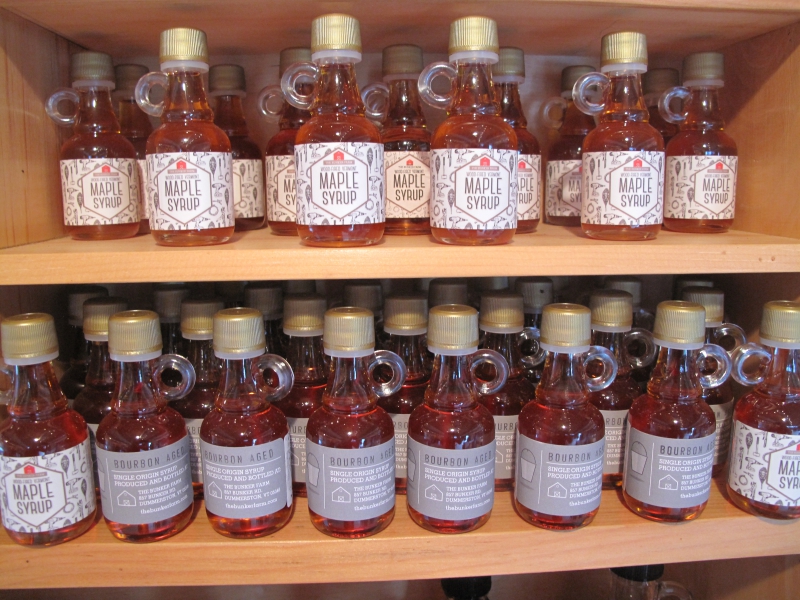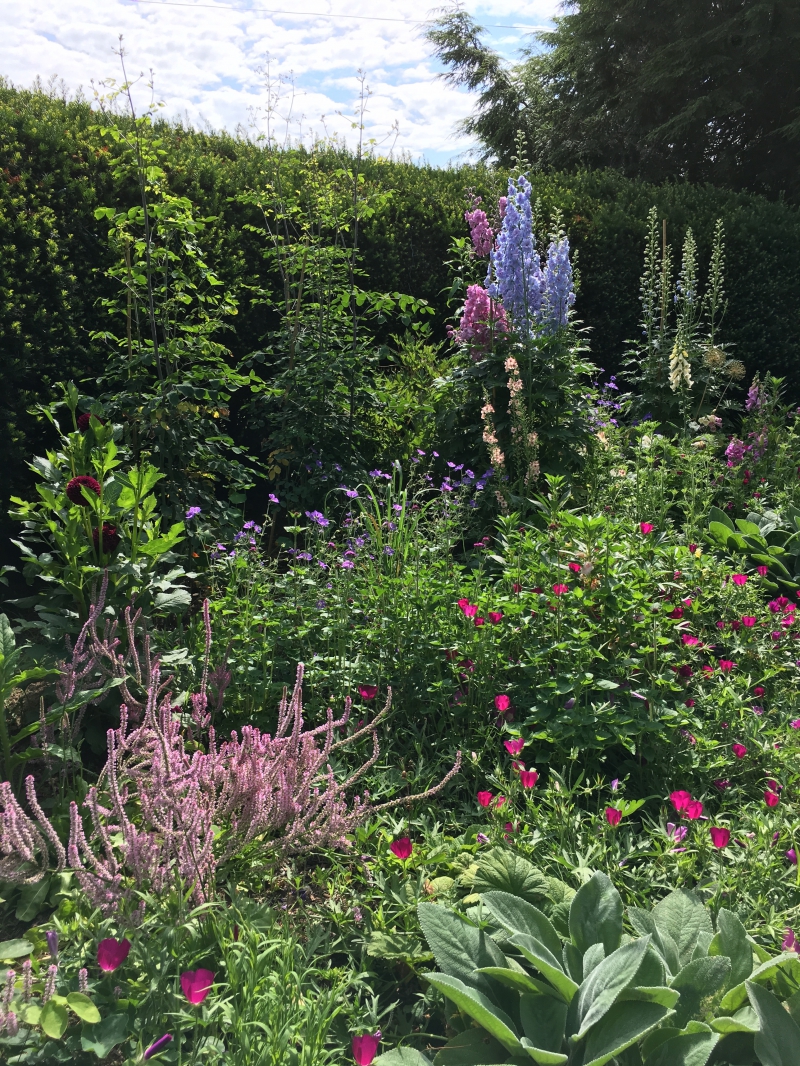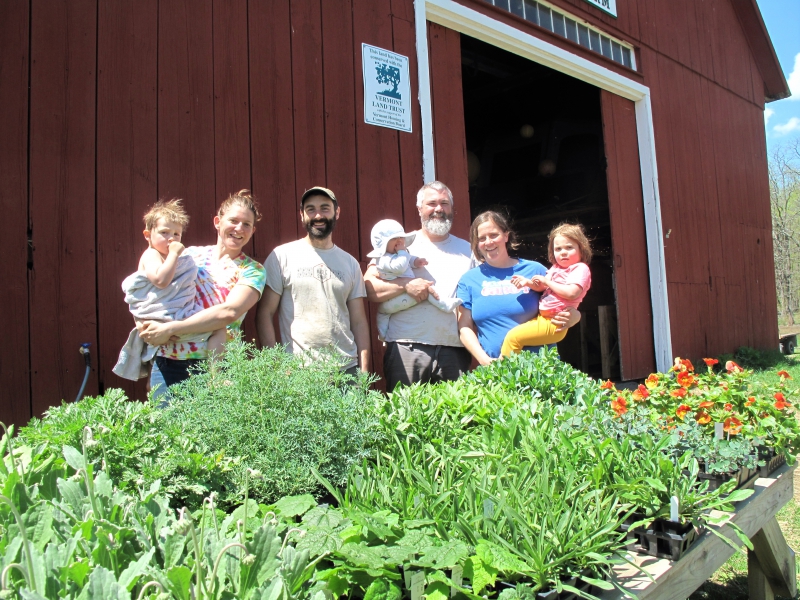
From left to right are Avery Euphrat, Jen O’Donnell, Mike Euphrat, Nell Hoskins, Noah Hoskins, Helen O’Donnell, and Suzanna Hoskins.
By Laurie Merrigan
What a story: Helen O’Donnell and Jen O’Donnell, two gals from Maine, marry two guys from Vermont and they move to a working farm with piglets, pastured beef and poultry, flower and vegetable greenhouses, and a maple bush. It’s also an agricultural educational center for students and the community and an emerging event space. Hard work, but for some it’s the only way to live.
In addition to beautiful children, a cooperative of dogs, pigs, meat birds, cows, and a massive sugaring operation, everyone has a specialty. Noah runs the animal husbandry part of the farm; sister Jen is involved with education projects; Mike runs the maple syrup part of the business; and Helen is the plant guru, managing the greenhouse, a garden design business, and ordering the seeds.
Helen knows her plants, but then again, she has been well trained and is well connected. Helen sows and grows all of the seedlings beginning in cold and snowy February. Plants are moved out early, which hardens them off, she says,
Rare and unusual annuals—some common ones, too—are a specialty, all seed-raised, propagated from cuttings, or divided from perennial stock and available in six packs and 4-inch pots as sturdy, well hardened-off plants ready to go into your garden.
The seed is carefully ordered from the finest suppliers of unusual seed, like private growers in England (including Great Dixter), and such catalogs as Chiltern.
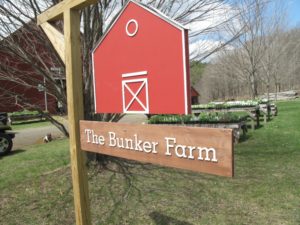 Expect the extraordinary, both in selections and in plant material. Here are plants that you’ll find nowhere else, unless you raise them yourself. Asclepias currasavica seedlings were robust and well branched. If you’re looking for those hard-to-raise-from-seed annuals, such as poppies, this is the place—but get there early in the season.
Expect the extraordinary, both in selections and in plant material. Here are plants that you’ll find nowhere else, unless you raise them yourself. Asclepias currasavica seedlings were robust and well branched. If you’re looking for those hard-to-raise-from-seed annuals, such as poppies, this is the place—but get there early in the season.
Clearly, given the selections and varieties found only on secret seed lists and the finest seed catalogs from England and the United States, this is the kind of place where a plant person can go wild.
We found Helen working away in the heady oxygenated atmosphere of the busy Bunker Farm greenhouse. We worked side by side, transplanting into plug trays what would be moved again in a few weeks time to 4-inch pots.
“As a gardener, I listen to sites and clients,” Helen said. “What wants to happen here? It’s very personal. I can’t just sit at the kitchen table and do it in 10 minutes. I spend time getting to know my clients. Not just their favorite colors, but what appeals to them—so that I can understand who they are as people.
“I feel like I’m there to help design, but it’s their thing, their own life is there. Over the years they come to trust me. I say try this plant and they do and all of a sudden they have a new favorite.
“For example, I have one client now who is in love with Nemophila, or the cultivar known as ‘snow storm.’ She trusted me enough to try it and now she loves it.”
Helen has worked and studied extensively in England, where she says the garden is so specific to its site and its house and its people.
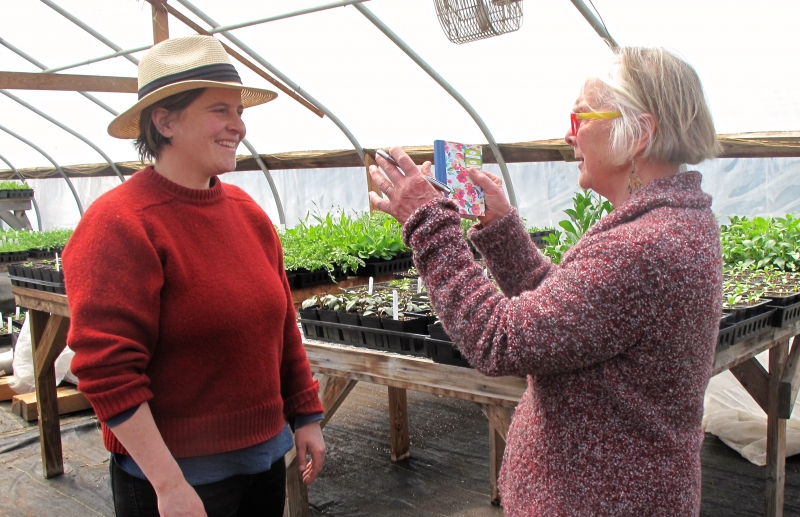
Helen O’Donnell assists Virginia Newell, a customer who made a pilgrimage from the Springfield, Mass., region. “She says that she brings her list and that ‘it’s definitely worth the trip’!” Helen says.
“You feel that,” Helen said. “Think about Hidcote and Great Dixter: Even though they‘re very different, they are both about the house and landscape and the person that created each of them.”
She added, “The garden is so much about who they were and what they wanted to do and be, and what they were interested in. It’s the places they traveled to and the people they exchanged plants with—their personalities come through.”
Then she instructed me in watering the seedlings with a gentle side-to-side motion with the wide-mouthed watering can. When I ask about her plant choices her response—like her busy life—is ambitious and joyful.
“I don’t want to repeat myself over and over; that’s easy to do when you have access to 300 plants. I certainly do that, but I’m always trying to introduce new plant material, new combinations, and plant styles,” she said.
“That’s true whether it’s gravel gardens, a wild garden, a shade garden, or just borders that feel different,” she explained.
“I guess my philosophy is to use really diverse plantings. I’m not a purist in any form. I’m not a native-plants person, I’m not an annuals person; I’m everything. I want it all together: the whole mix. I think that’s beautiful, and ultimately I believe that it’s good for our environment. Year ‘round, or at least nine months of it.”
We moved the large pots of now vigorously sprouted canna tubers that had wintered in the basement but now sport wide, healthy new leaves.
“Like design work, I’m not particularly happy with formulaic plant growing,” she said.
“I want to push that artistic piece and I try to get access to as many plants as possible, either growing them or buying them in from cool nurseries. Or propagating them, or dividing them and moving them all around,” Helen said.
“For example,” she said, “late season annuals are not only amazing for those butterflies before they head south, and to have your garden look as beautiful in October as it has all summer? Why wouldn’t you use them? That, to me, is hugely satisfying,” Helen said.
The sheer volume of plant seed choices that she’s growing is mind-boggling. I asked her about it.
“I started growing my own plants because I have this giant greenhouse. I went to Great Dixter in springtime, and little did I know how much seed sowing I was going to do, and I learned to sow seeds in this very specific Dixter way,” she explained.
“You learn to sow seeds into little pots. They germinate in their certain environments, then you prick them out into plug trays and then transplant again into bigger pots.”
She added, “I realized that most times when you go to a nursery, you don‘t have the option to buy an annual or a perennial in a 4-inch pot. Which is kind of an ideal plant size to put in the garden. Especially an annual, because you get three or four times the plant. Although I still sell some plants in six-packs like verbenas, zinnias, and cosmos.”
She explained with passion, “I like the rhythm of sowing from seed. It feels very natural to grow this way. And all of the genetic diversity you get in each seedling—unusual things that can happen.”
And it’s time-consuming, she said.
“Germinating takes an incredible amount of attention. You can’t let them dry out. You can‘t let them get too hot. I‘m constantly moving pots around to find their ultimate zone. You have to remember that your euphorbias are pretty happy out on the table on a heat mat, getting cooler at night. And poppies don’t want to be too wet. Verbenas absolutely want to be as hot as possible. These kinds of things.”
She smiled broadly and said, “And you just hope for the best.”
If your goal is to make money, she said, this isn’t the right way to do it, explaining it’s much easier to buy in plugs. But that’s not her goal. She does this so she can get plants that don’t otherwise grow in this area.
“Half the plants I grow just don’t exist here. I want to use them here in my own gardens and for clients. There’s a huge amount of practicality in that. And I might as well sell to other people who want interesting plants,” she said.
As we moved another tray of enthusiastic shoots to a crowded table—the last in a long row of full tables—I asked, “Is there a market here for what you grow?”
“Definitely,” she said. “Even if it’s only 25 devout followers, that’s all it takes, really. And then they become friends. I also do a couple of trade shows, including Trade Secrets in Sharon, Connecticut, founded by Bunny Williams. That’s a fun way to interact with other serious gardeners. This year for example, they’re hosting a book signing with Martha Stewart.”
The sun has peeked out. The temperature had been rising. Helen turned on the fan, dropped her sweater to a chair, and continued.
“Hopefully there is something for everybody, but I rely on the nerdy plants person or gardener for unusual stuff who want to try something they’ve never grown. It might not look like much in its little pot, but if that person knows anything about the genus or the family of plants—or it just sounds cool—that’s enough for most gardeners to try it,” she said.
And then they’ll come back year after year, and try a couple of new things.
For Helen, the list of “gotta-haves” keeps growing and changing.
She said, “I have my standbys and I’m always adding or taking away. I’ll say, Let’s take a year off and try it again another year. I’m always trying to figure out how to grow it better. So it stays interesting; this serves my own intellectual interest.”
At the end of the day, she asked rhetorically, “What else am I going to do with this big, beautiful greenhouse? To help this farm? On an 8-degree day in February?”
_______________________
A local legacy: Ellsworth Bunker purchased 600 acres of The Bunker Farm in 1951 after retiring. He was an American businessman and diplomat (including being the ambassador to Argentina, Italy, India, Nepal and South Vietnam). Ellsworth died on his dairy farm in 1984 at 90. A smaller section of the farm was purchased by Larry and Marilyn Cassidy in 1986, then sold to the Vermont Land Trust in 2012. In 2014, the O’Donnell Family Company bought the farm from the land trust and conserved 169 acres. They kept the name—Bunker Farm—and now use the land for: 1) pasture-raised meat and poultry, 2) annual and perennial plants, 3) maple sugaring, and 4) educational and community programming. The farm conservation project was supported by the Vermont Housing & Conservation Board, USDA Natural Resources Conservation Service, the 1772 Foundation, Town of Dummerston Farmland Protection Fund, and local contributions of more than 150 individuals.
Nestled on a quiet country dirt road, 857 Bunker Road, Dummerston, Vermont, The Bunker Farm is open on Wednesdays from 3:30 to 7 p.m. and Saturdays from noon to 5 p.m. You can write Helen at thebunkerfarm@gmail.com and visit her at http://www.thebunkerfarm.com. And we’re not the only ones gushing about Helen O’Donnell and The Bunker Farm. Check out plantsman Matt Mattus’ blog, http://www.growingwithplants.com, which informed this story.


